Geography of Ethiopia: Important Geographical Information about Ethiopia
In this Country Profile
It can be considered as something of an irony that a place like Ethiopia that suffers severe droughts should be the source of the water that flows to the Nile River, a very important river that makes the Nile Valley fertile and vital to Egypt’s livelihood. The Blue Nile originating from Lake Tana connects with the White Nile located in Sudan before it flows into the Nile. The Blue Nile is so named because when its water level is at its highest volume the water turns almost black, which in the Ethiopian dialect translates to blue. It is even considered as holy as many believed that the Blue Nile is the River Gihon from the Garden of Eden.
Ethiopia is located in the Horn of Africa, the easternmost projection of the continent of Africa towards the Arabian Sea. However, Ethiopia is itself landlocked, since its previous province, Eritrea, which borders the Red Sea became independent. Its latitude is 8° 00’ north of the equator while its longitude is 38° 00’ east of the prime meridian in Greenwich.
It is landlocked by Somalia on the east and southeast, by Sudan in the west, by Djibouti in the northeast, by Eritrea in the north and by Kenya in the south. The total length of its boundary is 5,311 kilometers. In terms of the sizes of African countries, Ethiopia ranks as 10th largest and 3rd in population size. Its lowest point, the Danakil Depression is 125 meters below sea level while its highest elevation, the Ras Dashen is 4,620 meters above sea level. The Danakil Depression is also called the Afar Triangle or the Afar Depression where most of the fossil evidence of hominids and prehistoric tools are found.
It has several highland plateaus and mountains. The country is significantly divided into the highlands and lowland plains surrounding the country side, divided almost in half by the Great Rift Valley. This diversity greatly affects the variations in natural vegetation, settlement patterns of the people, the soil composition and the climate conditions in the different regions.
Climate
Ethiopia has three environmental zones – dega or the highlands, weina dega or the mid-highland and the kolla or the lowlands. These three environmental zones conform to the three temperature patterns prevalent in Ethiopia- cool, temperate and extremely hot, respectively.
The cool areas are located in the central areas of the eastern and western sections along the plateaus on the northwestern part of the country and some parts of Harer, which is close to Djiboun. Land areas in these sections are about 2.400 meters in height. High temperatures that can be felt daily are almost near-freezing, usually averaging 60.8° F. The warmest months are from March up to May but the warmth during the day dissipates quickly by the afternoon and the nights are cooler. Light snow and frost may occur at nighttime.
Those areas that are about 1,500 to less than 2,400 meters in elevation experience temperate climate where the average temperature normally ranges from 60° F to about 86° F. Comparatively, the hotter areas are those that rise no higher than 1,500 meters, which are considered the lowlands in Ethiopia. Most of these areas included the Danakil Depression, which is the lowest point in Ethiopia, the eastern part of Ogaden near Somalia, the areas closer to the Kenyan and Sudanese boundaries as well as the deep tropical valleys of the Tekeze River and the Blue Nile River. Temperatures around these regions are vastly different, with an average annual temperature of 80.6° F. In the areas nearer to the coast of the Red Sea, the condition is usually humid with the average temperature during the middle of the year going as high as 122° F. Around Ogaden arid conditions exist and the average temperature is close to 104° F.
The different elevations also affect the rainfall patterns in Ethiopia. In the highlands rainfall is regular throughout the year. In the mid-highlands, rainfall becomes seasonal while rainfall in the lowlands can be scant. The high pressure system coming from the Red Sea and Asia at the start of the year brings cool and dry air, giving the areas near the coast a climate that is basically Mediterranean. However, when the winds are coming from the Atlantic Ocean, they invariably bring rain that can prevail from the middle of June up to the middle of September of each year.
As Ethiopia’s biggest industry is agriculture, with coffee its major export, the extreme weather patterns and its landlocked position makes its economy precarious. It is hard to transport their goods for export because access to ports is difficult. Droughts can severely affect the country’s agricultural production.
Nature
Just like the weather patterns in Ethiopia, its natural beauty is also diverse. Rugged mountains, 25 of which are more than 4,000 meters high slope down to broad savannahs. There are also numerous lakes and rivers, with volcanic lakes in the Great Rift Valley where you can find breathtaking vistas, awe-inspiring escarpments and unique flora and fauna, some of which are indigenous to Ethiopia.
:: References ::
http://www.mongabay.com/reference/country_studies/ethiopia/GEOGRAPHY.html
http://www.imperialethiopia.org/history1.htm
http://www.ethiopiantreasures.co.uk/pages/climate.htm
http://library.thinkquest.org/05aug/01259/terrain_and_weather.htm
http://www.ethemb.se/ee_eth_geog.html

Sorry, the comment form is closed at this time.